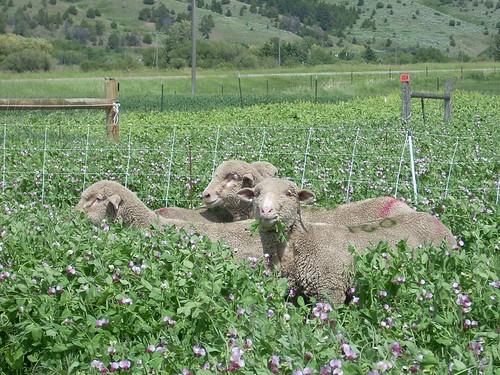
Environmental and economic management of weeds and pests is a priority for organic farmers and they typically use tillage to address these issues. However, frequent mechanical tillage can reduce soil integrity, which increases costs for farmers and negatively impacts future crop growth. Now, Montana State University (MSU) researchers are studying an alternate technique to manage these issues—domestic sheep.
Instead of using traditional tilling machinery or herbicides, MSU’s project features domestic sheep that graze farmland to eliminate the cover crop and control weeds. The study will determine if an integrated animal and crop production system is an economically feasible way to reduce tillage for certified organic farms.
USDA’s National Institute of Food and Agriculture (NIFA) is supporting the research with a four-year, $742,907 Organic Transitions grant. The project involves faculty, graduate and undergraduate students from varied fields that include agronomy, weed ecology, animal and range sciences, community development, political science, entomology, soil science, and agricultural economics.
“Our goal is to reduce tillage in organic systems. The ideal system would probably be where both grazing and tillage are employed strategically to accomplish a site specific service,” said Patrick Hatfield, MSU animal and range sciences professor who is part of the research team.
The processing of the cover crops through the sheep’s digestive tracts also lends itself to long-term soil health benefits.
“A sheep is only going to digest 30-40 percent of 100 pounds of wheat straw consumed. That means 60-70 pounds of small particle organic matter is being returned to the soil, mixed with a bunch of microbial cell fragments from the sheep’s digestive tract. It’s a great way to process crop residue while still providing some energy to the grazing sheep,” Hatfield said.
Cropping systems are complex. To find a balance between economic return, productivity, and sustainability, MSU’s multidisciplinary project team is using a system-level approach.
“I think one of the major points we have learned is that there is a definite, strategic, environmentally sustainable and cost-effective use of all the methods (tillage, grazing, and herbicide). The most sustainable farming practices would probably include the strategic use of all these tools,” Hatfield said. “In other words, rather than using [only] tillage, or fertilizer, or herbicides to drive the farming system, these inputs are limited and used strategically in combination with grazing, crop rotations, and cover crops to enhance production.”
Determining the best methods for using all of these methods is the next phase.
“It’s been a useful learning exercise to strongly contrast different management options within a common crop rotation. But the next generation of this research will need to think harder [about] how to integrate these systems,” said Perry Miller, MSU professor of land resources and environmental sciences research team member.
For more information on this project, watch MSU’s video on Youtube.
NIFA invests in and advances agricultural research, education and extension and seeks to make transformative discoveries that solve societal challenges.
